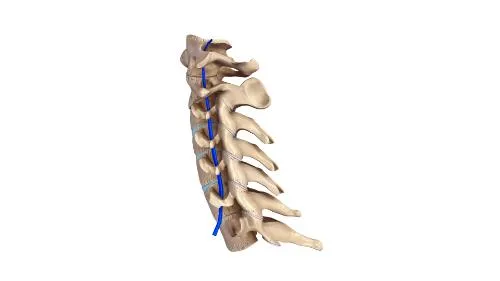
What Chiropractic Patients Need to Know About the Cervical Spine
Neck pain is one of the most common sources of pain and chronic pain worldwide. According to the International Association for the Study of Pain, each year, around 30% to 50% of the general population experiences neck pain and around 15% will, at some point in their lives, have chronic neck pain. Women seem to experience it more often than men and it is most prevalent at around middle age. Neck pain can be debilitating, impacting a person home life as well as their work performance. It can also trigger migraines and limit range of motion. Understanding the cervical spine is integral in understanding how to manage pain in that area.
What is the Cervical Spine?
There are seven vertebrae that make up the cervical spine: C1 through C7. They protect the spinal cord and are part of the system that makes up the neck.
C1 is located at the base of the skull and C7 sits at the beginning of the thoracic spine. While C1 is the smallest vertebrae, each subsequent one is slightly larger as you move down the spine. This is necessary because the farther down the spine, the more weight it must bear.
The vertebrae C3 through C6 are called “typical vertebrae.” Like other vertebrae in the spine, they have a similar construction. The top vertebrae, C1 and C2 are “atypical vertebrae.” Their construction is somewhat different from typical vertebrae due to their specialized function and location.
The atlas, C1, is the only vertebrae that has more of a ring shape than a shape resembling a vertebra. It is what connects the skull to the spine and is responsible for about half of the head’s backward and forward range of motion.
The axis, C2, is the second vertebra and has a special construction that connects it to C1 at the atlanto-axial joint. It is responsible for around half of the head’s rotation. The vertebra prominens, C7, is much larger than the vertebrae that sit above it and its shape is different to facilitate its connection to T1, at the beginning of the thoracic spine.
Neck Pain
The cervical spine has several critical functions. It houses the spinal cord and protects it, supports the head and facilitates its movement, and facilitates the flow of blood to the brain.
The human head is around 10 to 13 pounds and the cervical spine, along with an intricate network of muscles, tendons, and ligaments support it. This is what also allow flexibility to the head so that it can move up and down, backwards and forwards, rotational, and side bending. This job alone puts a great deal of stress on the neck and can lead to neck pain. Common causes of neck pain include:
Whiplash (whipping the head forwards and then backwards very suddenly)
Degenerative disc disease
Pinched nerve
Age related conditions
Spinal stenosis
Sleeping in certain positions
Neck strain
Osteoarthritis
Keeping the neck in one position too long, such as looking down at a mobile device
Herniated disc
Neck injury
Fibromyalgia
Chiropractic Care for the Cervical Spine
A chiropractor will typically treat a patient with neck pain using cervical spinal manipulation, cervical spinal mobilization, or a combination of the two techniques. Cervical spinal manipulation is what most people think of regarding chiropractic treatment. It involves brief, quick thrusts that focus on a single joint at a time so that range of motion is returned to that area. Cervical spinal mobilization is a gentler, lower impact adjustment that does not use as much force but does move the joint to its correct position.
Other treatments the chiropractor may employ include the application of cold or heat, massage, and exercises to strengthen and stretch the neck. The doctor will carefully consider the patient, their lifestyle, habits, and current level of fitness then create a plan that is tailored specifically for them that will help them manage their pain and return flexibility and range of motion as quickly as possible.
This article is copyrighted by Blogging Chiros LLC for its Doctor of Chiropractic members and may not be copied or duplicated in any manner including printed or electronic media, regardless of whether for a fee or gratis without the prior written permission of Blogging Chiros, LLC.
Office Hours
Mon 8:00-12:30, 2:30-7pm
Tues 8:00-12:30, 2:30-7pm
Wed 8:00-12:30, 2:30-7pm
Thurs 8:00-12:30, 2:30-7pm
Fri - Sun Closed
© 2025 Gonstead Chiropractic Center - All Rights Reserved


